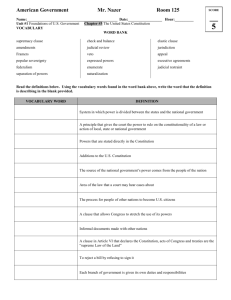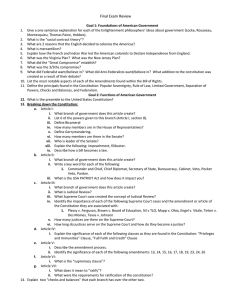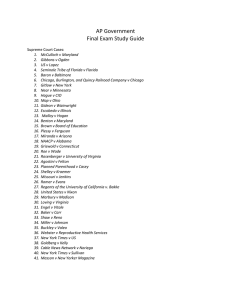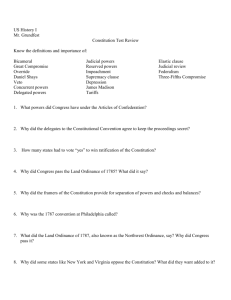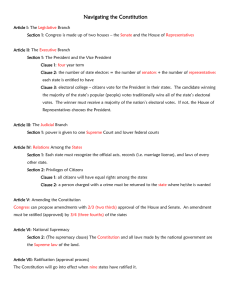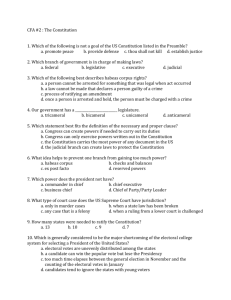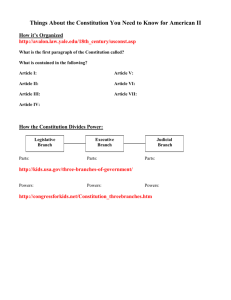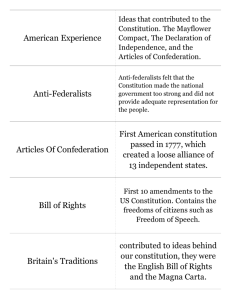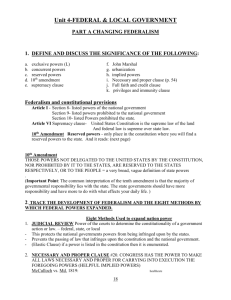Civics and Economics Mid-Term Review Sheet
advertisement
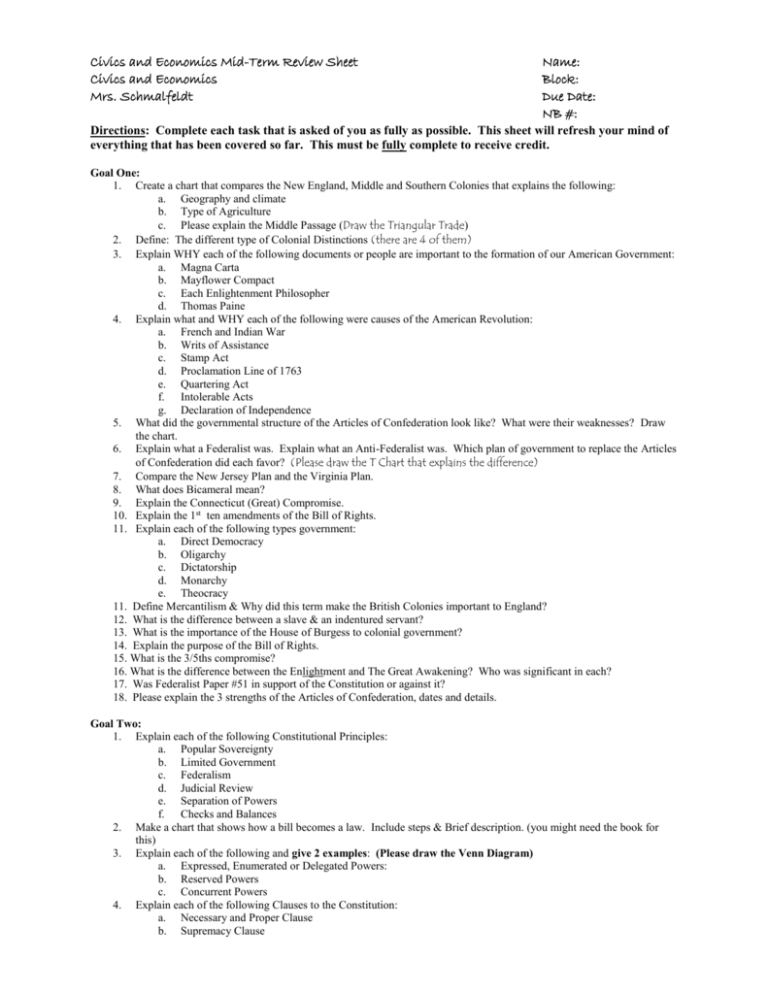
Civics and Economics Mid-Term Review Sheet Civics and Economics Mrs. Schmalfeldt Name: Block: Due Date: NB #: Directions: Complete each task that is asked of you as fully as possible. This sheet will refresh your mind of everything that has been covered so far. This must be fully complete to receive credit. Goal One: 1. Create a chart that compares the New England, Middle and Southern Colonies that explains the following: a. Geography and climate b. Type of Agriculture c. Please explain the Middle Passage (Draw the Triangular Trade) 2. Define: The different type of Colonial Distinctions (there are 4 of them) 3. Explain WHY each of the following documents or people are important to the formation of our American Government: a. Magna Carta b. Mayflower Compact c. Each Enlightenment Philosopher d. Thomas Paine 4. Explain what and WHY each of the following were causes of the American Revolution: a. French and Indian War b. Writs of Assistance c. Stamp Act d. Proclamation Line of 1763 e. Quartering Act f. Intolerable Acts g. Declaration of Independence 5. What did the governmental structure of the Articles of Confederation look like? What were their weaknesses? Draw the chart. 6. Explain what a Federalist was. Explain what an Anti-Federalist was. Which plan of government to replace the Articles of Confederation did each favor? (Please draw the T Chart that explains the difference) 7. Compare the New Jersey Plan and the Virginia Plan. 8. What does Bicameral mean? 9. Explain the Connecticut (Great) Compromise. 10. Explain the 1st ten amendments of the Bill of Rights. 11. Explain each of the following types government: a. Direct Democracy b. Oligarchy c. Dictatorship d. Monarchy e. Theocracy 11. Define Mercantilism & Why did this term make the British Colonies important to England? 12. What is the difference between a slave & an indentured servant? 13. What is the importance of the House of Burgess to colonial government? 14. Explain the purpose of the Bill of Rights. 15. What is the 3/5ths compromise? 16. What is the difference between the Enlightment and The Great Awakening? Who was significant in each? 17. Was Federalist Paper #51 in support of the Constitution or against it? 18. Please explain the 3 strengths of the Articles of Confederation, dates and details. Goal Two: 1. Explain each of the following Constitutional Principles: a. Popular Sovereignty b. Limited Government c. Federalism d. Judicial Review e. Separation of Powers f. Checks and Balances 2. Make a chart that shows how a bill becomes a law. Include steps & Brief description. (you might need the book for this) 3. Explain each of the following and give 2 examples: (Please draw the Venn Diagram) a. Expressed, Enumerated or Delegated Powers: b. Reserved Powers c. Concurrent Powers 4. Explain each of the following Clauses to the Constitution: a. Necessary and Proper Clause b. Supremacy Clause 5. 6. 7. 8. 9. 10. 11. 12. 13. 14. 15. 16. 17. c. Free Exercise Clause d. Full Faith and Credit Clause e. Establishment Clause Answer the following questions about the Presidency: a. How does the President get his/her job? b. What is the President’s Cabinet? c. What has to happen when the President signs a treaty or makes an appointment? How does a Supreme Court Justice get his job and what are the terms of office for a Supreme Court Justice? What is the Importance of the case Marbury v. Madison? Why are the First, Fourth and Fourteenth Amendments sooo important? Explain the importance of all the following landmark Supreme Court Cases: Include relation to constitution. I will be looking for 20 of them…including the NC Landmark Cases What is a Regressive Tax? What are some examples of Regressive Taxes? What is a Progressive Tax? What is an example of Progressive Taxes? List & Explain the 4 types of Jurisdiction the U.S. Court System uses? Please explain the 3 branches of government and what each branch does. How is representation based in both the Senate and the House of Representatives? Please explain the different types of taxes. Property, Sales, Excise, Estate. What is the difference between a Deficit and a Surplus? *If both the President & Vice President are unable to serve – who takes over? Goal Three: 1. What is found in the following Articles of the North Carolina Constitution? a. Article I b. Article II (What is the name for it? how long do they serve for?) c. Article III d. Article IV 2. Where do county and local governments get their powers? 3. Where does the largest amount of North Carolina’s revenue come from? 4. What do states spend most of their revenue on? 5. Explain each of the following types of Local Government: a. Council-Manager plan b. Council-Mayor plan 6. North Carolina’s Declaration of Rights is similar to what part of the U.S. Constitution? 7. What is a Metropolis? 8. What is the General Assembly? 9. Please explain Initiative and Referendum. 10. What is Gerrymandering? 11. What is annexation? 12. What are some (at least 3) qualifications for voting in North Carolina? 13. What is the difference between a Statute and Ordinance? Goal Four: 1. What are political parties and why are they important to the American political process? 2. What are the two dominate parties in America? 3. What is the difference between a liberal & a conservative? 4. How are political platforms important to elections? 5. What is the difference between a political platforms and plank? 6. What is apathy & why does this occur in America? 6. Electoral College: a) What is the significance? b) How does one figure out how many electoral votes each state has? c) Why would the Electoral College cause voter apathy in America? 7. What is the difference between Primary Elections & General Elections? 8. What are lobbyists and why are they important to the American political system? & why would people oppose lobbyists? 9. Please list and explain the significance of the voting amendments. 10. Please draw and label the political spectrum. 11. Where do most Americans fall on the spectrum? 12. What is an interest group? Lobbyist? 13. Please list and explain all of the types of ads that we have learned. (provide an example if necessary) 14. What is the difference between a duty and a responsibility? 15. Please explain Public Service in your own words. 16. What is Apathy? 17. What is the difference between a Platform and a Plank? 18. What is Canvassing? 19. Which method of advertising reaches the most potential voters? 20. What is a Political Action Committee?


